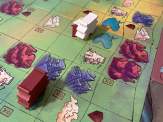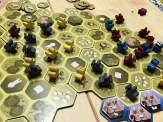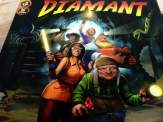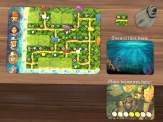| Release Date: 2015 | Players: 2-4 |
| Designer: Rüdiger Dorn | Length: 30-45 minutes |
| Artist: Claus Stephan | Age: 8+ |
| Publisher: HABA | Complexity: 1.5 / 5 |
| Plastic (by weight): 15% | Air (by volume): 75% |
Each of us was part of a team of four brave explorers who had spent months on the high seas to reach an island of myths and legends. All of us were on an expedition to navigate through dense jungle, trying to uncover paths that had been long lost and many of which were dead ends. If we were lucky we might find treasures along the way: gold nuggets or precious jewels. However, the riches along the way were mere trifles compared to our ultimate goal. Each of us wanted to be the first to reach one of the four temples whose tips we could see sticking out above the giant trees. These temples would reward us with unimaginable treasure and glory. We were determined to make history on the island of Karuba by Rüdiger Dorn from HABA.
I have previously played, and reviewed, this game in digital format and loved it so much then, that I simply had to buy myself a physical copy. Let me thank Jamie Adams at this stage for introducing me to this wonderful family tile-laying game, where you want to get your four explorers through the jungle to their relevant temple at the other end as quickly as possible. I made him and the rest of the games group play the game about a dozen times, one after the other, all in the same evening – and I don’t apologize for this at all.
Karuba in Physical Form
Let me give you a brief introduction to the game. Each player has a little, rectangular game board in front of them, representing the island of Karuba, with the beach on which their four explorers have landed on two sides, the jungle in the middle, which is divided into 6×5 squares, and the edge of the jungle on which the four temples are located. The game setup is random, but the same for every player. The four explorers, which come in four different colours, are each placed on one of the beach edge locations, then the temples, whose colours match those of the explorers, are similarly placed, but on the jungle edge.
Then one player randomly draws one of the 36 numbered jungle tiles and announces its number. All the other players then find that tile in their pile, which is hopefully still sorted numerically. Every player then decides where to place this tile. Tiles can be placed on any of the 30 jungle spaces on the player’s game board. There is no need to place them adjacent to each other or touch the sides. The only rules are that you can’t rotate tiles at all, once placed they can’t be moved and you can’t place one tile on top of another. That’s it.
The tiles show paths that allow the explorers to make their way through the jungle. Each tile will show the path exiting on between two and four edges. So there are straight paths, corners, t-junctions and crossroads. Additionally, a tile might show a gold nugget or gem. These are worth one or two points respectively at the end of the game.
Head for the Temples!
The biggest chunk of points come from reaching the temples though. These score more the earlier your explorer gets to the temple of each colour. So there are stacks of scoring tiles, one for each of the four temples. When you get there, you take the highest-value scoring tile. The second player to get to the same colour temple on their own board takes the next-highest scoring tile. So there is a bit of a race element in this game.
To enable your explorers to move, you need to discard a tile instead of placing it in the jungle. For every path exit printed on the discarded tile, you can move a single explorer one space forward. A crossroad has four path exits, which means you can move a single explorer four tiles along a continuous path. You can decide to move less, which may be a good idea, because you can only pick up gold or jewels when you stop on their tile. Otherwise, you’d be running straight past them.
Gold and jewels alone probably won’t win you the game, but you can’t ignore them, because temple scores alone are also unlikely to give you victory. You have to try and do both and also ensure you don’t work yourself into a corner as you place tiles. The decisions you make aren’t necessarily brain-burning, but they are important. They can create analysis paralysis in some players. However, as everyone’s jungle board is visible and public knowledge, players can try and copy each other. Mind you, that usually only lasts a couple of rounds. Sooner or later someone will think they’ve spotted a better place to put their tile and starts diverging from what everyone else is doing.
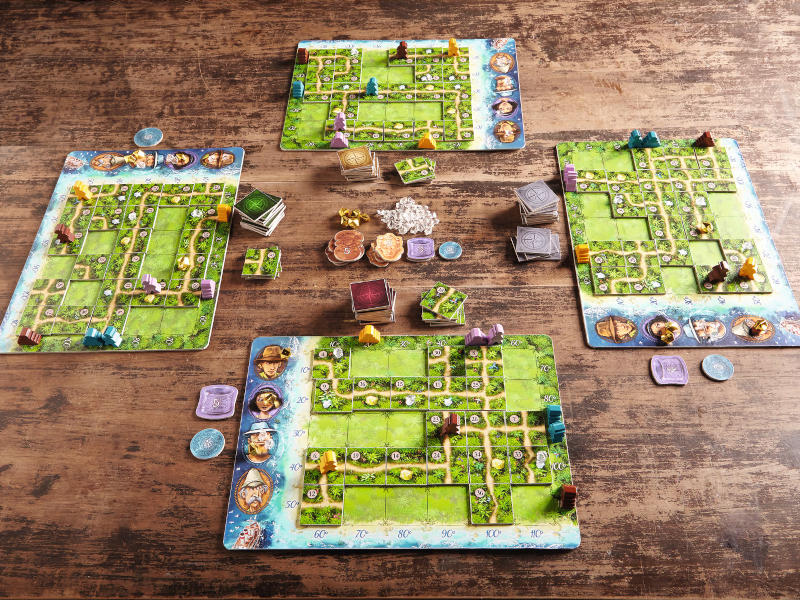
Physical versus Digital Karuba
The advantage of the digital copy of Karuba is that setup is very quick. There is no need to sort tiles in numerical order, which is what takes the longest in the physical version of the game. I say “setup”, but I suppose it depends on whether you sort all the tiles after you finished playing or if you just put everything in the box and then sort it out before your next game.
Play is also a little slower in the physical game, because everyone has to find the tile in their stack of 36 pieces. That’s not too bad, but over the whole length of a game, it does add a little extra time. It is also an extra effort that slightly detracts from the enjoyment of laying your paths and helping your explorers reach their temples.
However, the tactility of Karuba is actually really nice, giving the physical copy an edge over the digital version. The cardboard tiles are really thick and placing them into the perfect location on your jungle board is very satisfying. The gold nuggets and crystal jewels are represented by gorgeous plastic gems. That’s one of the rare occasions where I actually appreciate plastic being used in a game. They look really nice as they are strewn across the jungle.
Other than that, it is a bit disappointing that the game box is so very large. The size is based on the jungle game boards, which aren’t foldable. I suppose that would have added extra cost, but could have made the box a lot smaller. As it stands, most of it is air. The stacks of tiles and the plastic gems take up very little space and just rattle around in the box. It’s something I hate.
Family Fun
On the whole though, I’m really pleased I bought the physical copy. After all, when you play with the whole family, you don’t want to sit in front of computers or tablets. You want to be face-to-face. It’s only because I got the actual game, that I was able to introduce the wider family to this great game of cutting paths through dense jungle, picking up treasures along the way and becoming the first to reach the temples.
Of course, the game’s theme is all about looting treasures from foreign lands. I appreciate, it’s not a game about colonialism as such, but it’s not far removed from it. Yet, as you play Karuba, you don’t get any of that. You feel more like an Indiana Jones, or Indiana Jane, than an invader from Europe stealing precious historic artefacts from indigenous peoples. Even so, it’s far removed from what modern archaeological principles dictate. The game is portraying what was the norm a century ago or what is still portrayed on the big screen nowadays. Personally, I think we’re skirting on the right side of acceptable in Karuba, but of course, you have to decide if the theme of Karuba leaves a bad taste in your mouth.
If you enjoyed this article, please have a look at my support page to see how you can help keep the blog going.
Useful Links
- Karuba: https://www.
haba-play. com/ de-de/ p/ karuba& #8211;1300932 - Rulebook: https://boardgamegeek.
com/ filepage/ 126720/ official-english-rule-book - Digital Eyes review: https://tabletopgamesblog.
com/ 2021/ 08/ 14/ karuba-digital-eyes/ - HABA: https://www.
haba-play. com/ de-de/ - BGG listing: https://boardgamegeek.
com/ boardgame/ 183251/ karuba
Videos
Transparency Facts
I feel that this review reflects my own, independent and honest opinion, but the facts below allow you to decide whether you think that I was influenced in any way. Please also read my Ethics Statement for more information.- I bought and paid for the game myself.
- At the time of writing, I have not received financial support from the publisher or anyone working on their behalf.
Audio Version
Intro Music: Bomber (Sting) by Riot (https://www.
The following music was used for this media project:
Music: Twin Explorers by Alexander Nakarada
Free download: https://filmmusic.io/song/5108-twin-explorers
License (CC BY 4.0): https://filmmusic.io/standard-license
The following music was used for this media project:
Music: Buzzkiller by Alexander Nakarada
Free download: https://filmmusic.io/song/5820-buzzkiller
License (CC BY 4.0): https://filmmusic.io/standard-license
Artist website: https://www.serpentsoundstudios.com/



